Prague
Castle (Pražský hrad)
By Dana Shanberg
Records indicate that Prague Castle
is the largest castle area in the world. Its three courtyards
and a number of magnificent buildings cover over 7 hectares
(18 acres), so be prepared to see a lot and do some walking.
Depending on the time you have and your interests, you
can decide which interiors to visit.
Please check the current opening hours and ticket prices on the Prague Castle official website. |
|
If you plan to spend a few days in Prague, do some sightseeing, and take public transport, you can save some money and time if you buy the Prague Card, which also includes free entry to the Prague Castle.
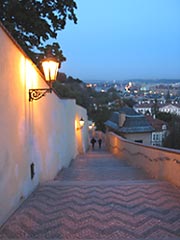
If
you would like to walk to the Castle, you have several options:
Nerudova
Street - walk up the picturesque (and quite
steep) Nerudova street from Malostranské náměstí
and at the top take a sharp right onto Ke Hradu.
You will end up in front of the main entrance to
the Castle.
Castle
Steps (Zámecké schody) - start up Nerudova
from Malostranské náměstí and take a quick right
onto Zámecká street. Then turn left to climb the
romantic Castle Stairs, which will take you to
the Garden on the Ramparts (Zahrada na Valech).
Old
Castle Steps (Staré zámecké schody) - the
stairs start near the Malostranská metro station
and will put you at the beginning of Jiřská street.
You will be rewarded with one of the most beautiful
views of Prague.
Taking the tram will save you a
walk uphill or up the stairs, and the ride is quite scenic.
Take tram
22 (e.g. from Národní třída or the Malostranská
metro station) and
get off
at one of these stops:
Královský
letohrádek -
if you get off here, you can start with the Royal Garden,
Belveder and Ballgame Hall, then cross
the Deer Moat bridge to get to the Second Courtyard
Note: The Royal Garden and Deer Moat are closed from November
through March
Pražský
hrad -
as its name suggests, this is considered the main Prague
Castle stop. Get off here if you would like to start at
the Second Courtyard.
Pohořelec -
getting off here will enable you to walk to the
Castle through Hradčany, past the Strahov Monastery and Loreta, and arrive at the main entrance.
This is probably the nicest route (and our favorite).
A good way to go is to take the tram up to
the Castle and walk back down when you're done.
Check tram schedules at dpp.cz.
The information below is based on the Czech language
version of the official Prague
Castle website.
 The Prague Castle (Pražský hrad)
was founded around 880 by prince Bořivoj of the Premyslid
dynasty. The first stone building
in the castle area was the Church of the Virgin Mary of
which only remnants can be seen today. In the 10th century,
St. George's Basilica was founded and the first Czech convent
was established there - St. George's Convent. St. Vitus Rotunda, also from the 10th
century, was replaced by St. Vitus
Basilica in the 11th century, and it
is where
St.
Vitus
Cathedral stands today. The Prague Castle (Pražský hrad)
was founded around 880 by prince Bořivoj of the Premyslid
dynasty. The first stone building
in the castle area was the Church of the Virgin Mary of
which only remnants can be seen today. In the 10th century,
St. George's Basilica was founded and the first Czech convent
was established there - St. George's Convent. St. Vitus Rotunda, also from the 10th
century, was replaced by St. Vitus
Basilica in the 11th century, and it
is where
St.
Vitus
Cathedral stands today.
Starting in the 10th century, the Prague
Castle served as the seat of Czech princes and later kings,
and the seat of the Prague bishop.
The
Prague Castle experienced one of its greatest periods
during the
reign of Charles
IV (1346-1378) when it became the seat of the Holy
Roman Emperor. The Royal Palace was rebuilt, the
fortifications were strengthened, and the construction
of St. Vitus Cathedral was initiated, following the
style of Gothic French cathedrals of the time.
The
expansion of the Castle continued during the reign
of Charles' son Wenceslas IV, but the Hussite wars
(1419 - 1437) and the subsequent decades during which
the Castle was abandoned lead to its deterioration.
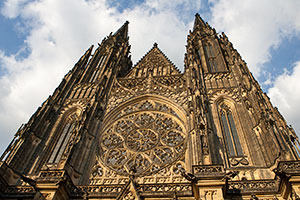 King Wladislaw Jagellon moved into
the Castle after 1483 and the
complex grew once again. New fortifications
and guard towers (the Powder Tower, New White Tower, and
Daliborka)
were built. The Royal Palace was further remodeled and
expanded by the grandiose Wladislaw Hall, one of the first
demonstrations of the Renaissance style in
the
Czech
lands. King Wladislaw Jagellon moved into
the Castle after 1483 and the
complex grew once again. New fortifications
and guard towers (the Powder Tower, New White Tower, and
Daliborka)
were built. The Royal Palace was further remodeled and
expanded by the grandiose Wladislaw Hall, one of the first
demonstrations of the Renaissance style in
the
Czech
lands.
By the time the Habsburg
dynasty took over the Czech throne in 1526, Renaissance
was in full swing in Europe. The seat of power moved
to Vienna and the Prague Castle served mainly for recreational
purposes. The Royal Garden was built and entertainment
sites such as
the Belvedere and Ballgame Hall were added in
the 16th century. The Cathedral
and Royal Palace were modified. New
residential buildings were built to the west of the Old
Royal Palace.
The
reconstruction of the Castle culminated during the
reign of Holy Roman Emperor Rudolf II who became
Czech king in 1575 and moved his court back to Prague.
He wished to turn the Castle into an elegant
center of power that would attract foreign
artists, scientists and diplomats.
The north wing of the Palace and the Spanish Hall
were
added
to house the emperor's vast collections of art and
science.
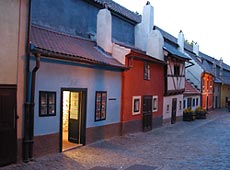 The Prague Defenestration of
1618 initiated a long period of wars during which
the Prague Castle was damaged and looted, rarely
serving as the seat of power. The Prague Defenestration of
1618 initiated a long period of wars during which
the Prague Castle was damaged and looted, rarely
serving as the seat of power.
The last large reconstruction of the Castle
took place in the second half of the 18th century when
it took on a style of a chateau. However,
the seat of power
was again
in Vienna and the Castle continued to deteriorate.
In 1848, emperor
Ferdinand V moved to the Prague Castle. The Chapel of the
Holy Cross on the Second Courtyard was rebuilt and the
Spanish
Hall
and
Rudolf's
Gallery were remodeled.
With the fall of the Austro-Hungarian empire
in 1918, the Prague Castle welcomed the first
president of
independent Czechoslovakia, Tomáš Garrigue Masaryk. Some needed
remodeling was commissioned to the Slovenian architect
Josip Plečnik. The construction of St.
Vitus Cathedral was finished in 1929.
After 1989, many
areas of the Castle were made accessible to the
public for the first time in history, including the Royal
Garden, Ballgame Hall, the south gardens, or the Imperial
Stables. Today, the Prague Castle is the seat of the
Czech president and the most important National Cultural
Monument of the Czech Republic. A number of priceless art
relics,
historical
documents,
as well as the Czech Crown Jewels are stored there.
| Recommended Hotels near Prague Castle: |
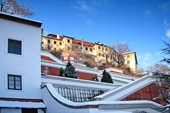 |
Golden Well 
U Zlaté Studně 166/4, Prague 1 - Lesser Town
This world-class boutique hotel enjoys a fantastic location right by the Prague Castle. The rooms overlook Prague's rooftops or the Royal Gardens, and the view from the open-air terrace is breathtaking. Exceptional service and a great range of luxurious amenities will make your stay at the Golden Well an unforgettable experience. |
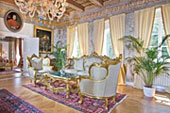 |
Alchymist Prague Castle Suites 
Sněmovní 8, Prague 1 - Lesser Town
The Alchymist Prague Castle Suites is an extraordinary small hotel located in a historical building at the foot of Prague Castle. It has just eight suites and feels private and quiet. The hotel prides itself in first-class service provided by friendly, helpful staff. The magnificent rooms are spacious and luxuriously furnished. |
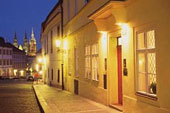 |
Domus Henrici Boutique Hotel 
Loretánská 11, Prague 1 – Prague Castle District
The Domus Henrici Boutique hotel enjoys a superb location in the Prague Castle area, between the Castle's main entrance, the Loreta Chapel and Strahov Monastery. Each room is equipped with free Wi-Fi. The terraces offer panoramic views over Prague. |
|